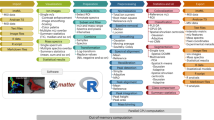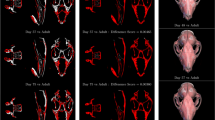Abstract
Magnetic resonance is an exceptionally powerful and versatile measurement technique. The basic structure of a magnetic resonance experiment has remained largely unchanged for almost 50 years, being mainly restricted to the qualitative probing of only a limited set of the properties that can in principle be accessed by this technique. Here we introduce an approach to data acquisition, post-processing and visualization—which we term ‘magnetic resonance fingerprinting’ (MRF)—that permits the simultaneous non-invasive quantification of multiple important properties of a material or tissue. MRF thus provides an alternative way to quantitatively detect and analyse complex changes that can represent physical alterations of a substance or early indicators of disease. MRF can also be used to identify the presence of a specific target material or tissue, which will increase the sensitivity, specificity and speed of a magnetic resonance study, and potentially lead to new diagnostic testing methodologies. When paired with an appropriate pattern-recognition algorithm, MRF inherently suppresses measurement errors and can thus improve measurement accuracy.
This is a preview of subscription content, access via your institution
Access options
Subscribe to this journal
Receive 51 print issues and online access
$199.00 per year
only $3.90 per issue
Buy this article
- Purchase on Springer Link
- Instant access to full article PDF
Prices may be subject to local taxes which are calculated during checkout





Similar content being viewed by others
References
Bartzokis, G. et al. In vivo evaluation of brain iron in Alzheimer disease using magnetic resonance imaging. Arch. Gen. Psychiatry 57, 47–53 (2000).
Larsson, H. B. et al. Assessment of demyelination, edema, and gliosis by in vivo determination of T1 and T2 in the brain of patients with acute attack of multiple sclerosis. Magn. Reson. Med. 11, 337–348 (1989)
Pitkänen, A. et al. Severity of hippocampal atrophy correlates with the prolongation of MRI T2 relaxation time in temporal lobe epilepsy but not in Alzheimer’s disease. Neurology 46, 1724–1730 (1996)
Williamson, P. et al. Frontal, temporal, and striatal proton relaxation times in schizophrenic patients and normal comparison subjects. Am. J. Psychiatry 149, 549–551 (1992)
Warntjes, J. B. Dahlqvist, O. & Lundberg, P. Novel method for rapid, simultaneous T1, T*2, and proton density quantification. Magn. Reson. Med. 57, 528–537 (2007)
Warntjes, J. B. Leinhard, O. D., West, J. & Lundberg, P. Rapid magnetic resonance quantification on the brain: optimization for clinical usage. Magn. Reson. Med. 60, 320–329 (2008)
Schmitt, P. et al. Inversion recovery TrueFISP: quantification of T1, T2, and spin density. Magn. Reson. Med. 51, 661–667 (2004)
Ehses, P. et al. IR TrueFISP with a golden-ratio-based radial readout: fast quantification of T1, T2, and proton density. Magn. Reson. Med. 69, 71–81 (2013)
Donoho, D. L. Compressed sensing. IEEE Trans. Inform. Theory 52, 1289–1306 (2006)
Candes, E. J. & Tao, T. Near-optimal signal recovery from random projections: universal encoding strategies? IEEE Trans. Inform. Theory 52, 5406–5425 (2006)
Lustig, M., Donoho, D. L. & Pauly, J. M. Sparse MRI: the application of compressed sensing for rapid MR imaging. Magn. Reson. Med. 58, 1182–1195 (2007)
Bilgic, B., Goyal, V. K. & Adalsteinsson, E. Multi-contrast reconstruction with Bayesian compressed sensing. Magn. Reson. Med. 66, 1601–1615 (2011)
Smith, D. S. et al. Robustness of quantitative compressive sensing MRI: the effect of random undersampling patterns on derived parameters for DCE- and DSC-MRI. IEEE Trans. Med. Imaging 31, 504–511 (2012)
Deshpande, V. S., Chung, Y.-C., Zhang, Q., Shea, S. M. & Li, D. Reduction of transient signal oscillations in True-FISP using a linear flip angle series magnetization preparation. Magn. Reson. Med. 49, 151–157 (2003)
Çukur, T. Multiple repetition time balanced steady-state free precession imaging. Magn. Reson. Med. 62, 193–204 (2009)
Nayak, K. & Lee, H. Wideband SSFP: alternating repetition time balanced steady state free precession with increased band spacing. Magn. Reson. Med. 58, 931–938 (2007)
Lee, K., Lee, H. & Hennig, J. Use of simulated annealing for the design of multiple repetition time balanced steady-state free precession imaging. Magn. Reson. Med. 68, 220–226 (2012)
Ernst, R. R. Magnetic resonance with stochastic excitation. J. Magn. Reson. 3, 10–27 (1970)
Scheffler, K. & Hennig, J. Frequency resolved single-shot MR imaging using stochastic k-space trajectories. Magn. Reson. Med. 35, 569–576 (1996)
Haldar, J. P., Hernando, D. & Liang, Z.-P. Compressed-sensing MRI with random encoding. IEEE Trans. Med. Imaging 30, 893–903 (2011)
Doneva, M. et al. Compressed sensing reconstruction for magnetic resonance parameter mapping. Magn. Reson. Med. 64, 1114–1120 (2010)
Stoecker, T., Vahedipour, K., Pracht, E., Brenner, D. & Shah, N. J. in Proc. 19th Scientific Meeting International Society for Magnetic Resonance in Medicine 381 (Int. Soc. Magn. Reson. Med., 2011)
Davenport, M. A., Wakin, M. B. & Baraniuk, R. G. The Compressive Matched Filter (Tech. Rep. TREE 0610, Rice University, 2006)
Tropp, J. A. & Gilbert, A. C. Signal recovery from random measurements via orthogonal matching pursuit. IEEE Trans. Inform. Theory 53, 4655–4666 (2007)
Schmitt, P. et al. A simple geometrical description of the TrueFISP ideal transient and steady-state signal. Magn. Reson. Med. 55, 177–186 (2006)
Lee, J. H., Hargreaves, B. A., Hu, B. S. & Nishimura, D. G. Fast 3D imaging using variable-density spiral trajectories with applications to limb perfusion. Magn. Reson. Med. 50, 1276–1285 (2003)
Marseille, G., De Beer, R., Fuderer, M., Mehlkopf, A. & Van Ormondt, D. Nonuniform phase-encode distributions for MRI scan time reduction. J. Magn. Reson. B. 111, 70–75 (1996)
Tsai, C. M. & Nishimura, D. G. Reduced aliasing artifacts using variable-density K-space sampling trajectories. Magn. Reson. Med. 43, 452–458 (2000)
Vymazal, J. et al. T1 and T2 in the brain of healthy subjects, patients with Parkinson disease, and patients with multiple system atrophy: relation to iron content. Radiology 211, 489–495 (1999)
Deoni, S. C. L., Peters, T. M. & Rutt, B. K. High-resolution T1 and T2 mapping of the brain in a clinically acceptable time with DESPOT1 and DESPOT2. Magn. Reson. Med. 53, 237–241 (2005)
Whittall, K. P. et al. In vivo measurement of T2 distributions and water contents in normal human brain. Magn. Reson. Med. 37, 34–43 (1997)
Poon, C. S. & Henkelman, R. M. Practical T2 quantitation for clinical applications. J. Magn. Reson. Imaging 2, 541–553 (1992)
Haacke, E. M., Brown, R. W., Thompson, M. R. & Venkatesan, R. Magnetic Resonance Imaging: Physical Principles and Sequence Design 669–675 (Wiley & Sons, 1999)
Hahn, E. L. Spin echoes. Phys. Rev. 80, 580–594 (1950)
Crawley, A. P. & Henkelman, R. M. A Comparison of one-shot and recovery methods in T1 imaging. Magn. Reson. Med. 7, 23–34 (1988)
Deoni, S. C. L., Rutt, B. K. & Peters, T. M. Rapid combined T1 and T2 mapping using gradient recalled acquisition in the steady state. Magn. Reson. Med. 49, 515–526 (2003)
Scheffler, K. & Lehnhardt, S. Principles and applications of balanced SSFP techniques. Eur. Radiol. 13, 2409–2418 (2003)
Needell, D. & Tropp, J. A. Cosamp: iterative signal recovery from incomplete and inaccurate samples. Appl. Comput. Harmon. Anal. 26, 301–321 (2009)
Goldstein, T. & Osher, S. The split Bregman method for L1-regularized problems. SIAM J. Imaging Sci. 2, 323–343 (2009)
Chartrand, R. & Yin, W. in Proc. ICASSP 2008 IEEE International Conference 3869–3872 (IEEE, 2008)
Wright, J., Yang, A. Y., Ganesh, A., Sastry, S. S. & Ma, Y. Robust face recognition via sparse representation. IEEE Trans. Pattern Anal. Mach. Intell. 31, 210–227 (2009)
Turk, M. & Pentland, A. Eigenfaces for recognition. J. Cogn. Neurosci. 3, 71–86 (1991)
Griswold, M. A. et al. Generalized autocalibrating partially parallel acquisitions (GRAPPA). Magn. Reson. Med. 47, 1202–1210 (2002)
Pruessmann, K. P. et al. SENSE: sensitivity encoding for fast MRI. Magn. Reson. Med. 42, 952–962 (1999)
Seiberlich, N., Ehses, P., Duerk, J., Gilkeson, R. & Griswold, M. A. Improved radial GRAPPA calibration for real-time free-breathing cardiac imaging. Magn. Reson. Med. 65, 492–505 (2011)
Heidemann, R. M. et al. Direct parallel image reconstructions for spiral trajectories using GRAPPA. Magn. Reson. Med. 56, 317–326 (2006)
Barger, A. V., Block, W. F., Toropov, Y., Grist, T. M. & Mistretta, C. A. Time-resolved contrast-enhanced imaging with isotropic resolution and broad coverage using an undersampled 3D projection trajectory. Magn. Reson. Med. 48, 297–305 (2002)
Perlin, K. An image synthesizer. Comput. Graphics 19, 287–296 (1985)
Hargreaves, B. A., Nishimura, D. G. & Conolly, S. M. Time-optimal multidimensional gradient waveform design for rapid imaging. Magn. Reson. Med. 51, 81–92 (2004)
Fessler, J. A. & Sutton, B. P. Nonuniform fast Fourier transforms using min-max interpolation. IEEE Trans. Signal Process. 51, 560–574 (2003)
Riffe, M. J., Blaimer, M., Barkauskas, K. J., Duerk, J. L. & Griswold, M. A. in Proc. 15th Scientific Meeting, International Society for Magnetic Resonance in Medicine 1879 (Int. Soc. Magn. Reson. Med, 2007)
Lin, L. I.-K. A concordance correlation coefficient to evaluate reproducibility. Biometrics 45, 255–268 (1989)
Acknowledgements
Support for this study was provided by NIH R01HL094557 and Siemens Healthcare. We also thank H. Saybasili and G. Lee for technical assistance during the implementation of these concepts; M. Lustig and W. Grissom for discussions regarding this work; and A. Exner, S. Brady-Kalnay, E. Karathanasis, E. Lavik and H. Salz for their assistance in preparing the manuscript.
Author information
Authors and Affiliations
Contributions
D.M., concept development, technical implementation, data collection and analysis, manuscript development and editing; V.G., concept development, manuscript development and editing; N.S., concept development, manuscript development and editing; K.L., concept development, technical implementation, manuscript development and editing; J.L.S., concept development, manuscript development and editing; J.L.D., concept development, manuscript development and editing; M.A.G., concept development, data collection and analysis, manuscript development and editing.
Corresponding author
Ethics declarations
Competing interests
This work was supported by Siemens Healthcare. K.L. is an employee of Siemens Healthcare.
Supplementary information
Supplementary Information
This file contains Supplementary Text and Data 1-3, Supplementary Figures 1-3 and additional references. (PDF 470 kb)
Time resolved in vivo images acquired from fully sampled MRF scan.
The video covers the first 50 time frames. Oscillations in signal intensity appear across all of the time frames. (AVI 979 kb)
Time resolved in vivo images generated from an accelerated MRF scan that acquired only 1/48th of the normally required data.
The video covers the first 50 time frames out of 1000. High intensity but incoherent undersampling errors are present in all time frames. (AVI 1521 kb)
The motion corrupted scan.
The subject started to move after 12 seconds of a 15 seconds acquisition. The video clearly shows the motion as well as severe aliasing artifacts from the highly undersampled data. (AVI 10015 kb)
Rights and permissions
About this article
Cite this article
Ma, D., Gulani, V., Seiberlich, N. et al. Magnetic resonance fingerprinting. Nature 495, 187–192 (2013). https://doi.org/10.1038/nature11971
Received:
Accepted:
Published:
Issue Date:
DOI: https://doi.org/10.1038/nature11971
This article is cited by
-
2.5-Minute Fast Brain MRI with Multiple Contrasts in Acute Ischemic Stroke
Neuroradiology (2024)
-
Evaluating contouring accuracy and dosimetry impact of current MRI-guided adaptive radiation therapy for brain metastases: a retrospective study
Journal of Neuro-Oncology (2024)
-
Nonuniform sliding-window reconstruction for accelerated dual contrast agent quantification with MR fingerprinting
Magnetic Resonance Materials in Physics, Biology and Medicine (2024)
-
Multiparametric quantification of T1 and T2 relaxation time of bone metastasis in comparison with red or fatty bone marrow using magnetic resonance fingerprinting
Skeletal Radiology (2024)
-
3D MR fingerprinting-derived myelin water fraction characterizing brain development and leukodystrophy
Journal of Translational Medicine (2023)
Comments
By submitting a comment you agree to abide by our Terms and Community Guidelines. If you find something abusive or that does not comply with our terms or guidelines please flag it as inappropriate.



